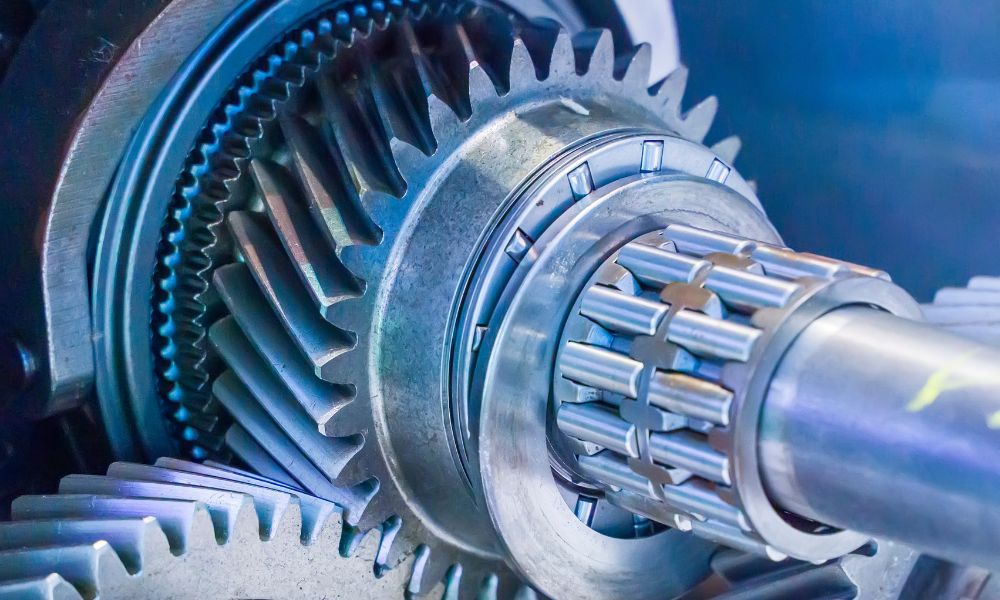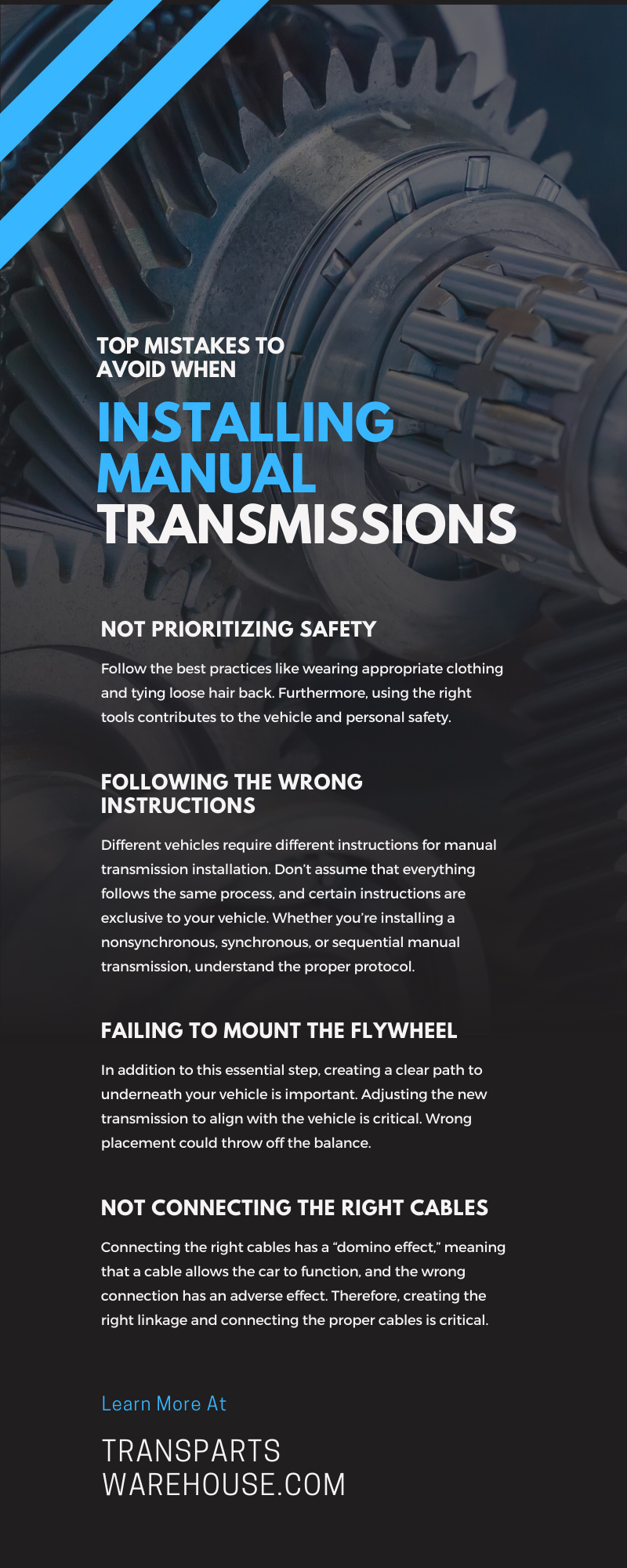
When it’s time to install a transmission inside your vehicle, it’s essential to treat this task with upmost care. Avoid troubling mishaps that can affect your vehicle and new part. Keep reading to understand the top mistakes to avoid when installing manual transmissions. Furthermore, learn about components that affect this vehicle part.
Overview of Manual Transmissions
Your vehicle’s transmission allows you to change gears while driving. It’s common to see many cars with automatic units, but manual transmissions are a part of many vehicles. If you own an older model or stick-shift, you have a manual unit inside your car. Although you can get a lot of miles on the transmission, there comes a time when you need a new unit. Fortunately, restoration is possible with new parts or a new manual transmission.
Service Options
Dealing with a faulty transmission is challenging, especially when obtaining a new part or replacing the unit. When it’s time for a part upgrade, assess your service options. Transmission replacement, repair, and rebuilds are the types of modifications you can consider. These options will help your vehicle function without shifting gear issues.
Transmission replacements refer to replacing your whole unit with a remanufactured part. This means that most of the part’s pieces are failing or worn out, and you can’t salvage most of the components. Although this is the most expensive option, replacements are necessary for different circumstances. Think of full replacements as a new start for your vehicle because you won’t have to worry about faulty parts.
On the opposite side of replacements, repairs are a great option for vehicle owners. In many cases, you’re repairing parts of the transmission so that it can function properly. When you purchase manual transmission replacement parts, use the new items to substitute for the old parts. Please note that some parts are more expensive than others, but it’s cheaper than an entire replacement.
Lastly, rebuilds refer to reassembling your transmission. This option is ideal for people familiar with vehicles and fixing various components. This is a cost-effective choice for helping your car with the right tools. After reassembling, reinstall the part inside your car to enjoy a better function.
Factors That Affect Transmission Costs
As previously mentioned, rebuilds are a cost-effective option for transmissions. However, repairs are also a great option that are less expensive than replacements. Depending on the service option, you can expect different costs for parts. Please keep in mind that the level of transmission damage, model of your car, and location influences the costs. When you receive updated parts or system, proper installation is critical for the well-being of your car.
Mistakes You Should Avoid
Transmission installation is a significant task, and you can successfully place one inside your vehicle. However, don’t let slip-ups put you on the wrong track. Here are some mistakes to avoid when installing manual transmissions:
Not Prioritizing Safety
Safety protocol is always the first thing to consider when servicing a vehicle. Of course, follow the best practices like wearing appropriate clothing and tying loose hair back. Furthermore, using the right tools contributes to the vehicle and personal safety. A transmission jack will help you during installation, and it’s an essential tool. Do not install a new unit without the jack. Carry other vital items in the installation to ensure that you have the right components.
Following the Wrong Instructions
Different vehicles require different instructions for manual transmission installation. Don’t assume that everything follows the same process, and certain instructions are exclusive to your vehicle. Whether you’re installing a nonsynchronous, synchronous, or sequential manual transmission, understand the proper protocol. This avoids misunderstandings that may damage your car.
Failing To Mount the Flywheel
After using the transmission jack, the next initial step for installation is to mount the flywheel. Don’t skip this step as you work on the process. In addition to this essential step, creating a clear path to underneath your vehicle is important. Adjusting the new transmission to align with the vehicle is critical. Wrong placement could throw off the balance.
Not Connecting the Right Cables
Connecting the right cables has a “domino effect,” meaning that a cable allows the car to function, and the wrong connection has an adverse effect. Therefore, creating the right linkage and connecting the proper cables is critical. You don’t want to risk malfunctions or accidentally injuring yourself. Read the transmission manual and cross-reference your vehicle to ensure accuracy.
Things That Can Damage Your Transmission
After understanding the mistakes to avoid when installing a transmission, it’s essential to acknowledge things that can damage your part. Here are some important things to keep in mind:
• Overlooking problems. If you notice odd occurrences like grinding noises while shifting gears, difficulty shifting gears, or leaking oil, this indicates a transmission problem. If you overlook these problems, things will become worse. Therefore, it’s essential to address issues and service your transmission.• Failing to get your manual transmission serviced. Every transmission needs a tune up from time to time, including yours. Professionals recommend getting the part serviced after driving between 30,000 to 60,000 miles. Between service times, it’s still important to inspect your transmission, and check for any problems.
• Letting the system overheat. Did you know that around 90 percent of transmission problems stems from excessive heat? High transmission fluid temperatures can damage your part and cause poor system performance. It’s critical that you keep your car cool and be mindful of your vehicle in hot climates.
• Running your vehicle with low transmission fluid. To deliver hydraulic pressure and cool your vehicle down, provide lubrication and help maintain your vehicle. Low fluid levels will cause your transmission to overwork itself to make up for the deficient liquid. Stay on the safe side with correct fluid levels at all times.
• Using the wrong transmission fluid. Just as bad as low fluid levels, the wrong fluid will generate problems too. Simply put, there is no one-size-fits-all transmission fluid. When you use the wrong product, you risk unpredictable hydraulic pressure and incorrect cooling properties. Read your vehicle’s manual to ensure that you use the right liquid.
Let Transparts Warehouse Help You
As your trusted source for transmission parts, Transparts Warehouse carries a wide selection of products for your vehicle. Whether it’s transfer case parts or rebuild kits, we only offer high-quality parts. When you need to install a transmission, use our parts for the best results. Let us help you repair your vehicle. Browse our website for supplies today!



